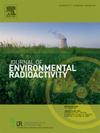Which radionuclides contribute most to seafood ingestion dose?
IF 2.1
3区 环境科学与生态学
Q3 ENVIRONMENTAL SCIENCES
引用次数: 0
Abstract
Radiological ingestion doses from eating seafood are regularly evaluated near coastal nuclear facilities, following accidents/events and frequently in national studies worldwide. However, a recent global review found that published seafood doses varied greatly depending on which radionuclides were selected for evaluation and that there has been a tendency to omit important radionuclides or focus on less significant ones. This indicates a need for clear guidance on which radionuclides to prioritise in such studies. Here, we use worldwide data for 16 key radionuclides contributing to typical background seafood ingestion dose. We account for the loss of radionuclides during cooking and the radioactive decay of the short-lived 210Po.
Results indicate that for the typical world consumer, naturally-occurring radionuclides account for >99 % of the total seafood ingestion dose, of which about 84 % comes from 210Po and 8 % from 210Pb. About 5 % comes from 228Ra, a far greater proportion than the more frequently-assessed 226Ra (<1 %). Other Th- and U-series radionuclides provide far lower contributions (0.07 %–0.70 %), while 14C provides about 0.09 %. In comparison, the contribution to total seafood ingestion dose from background anthropogenic radionuclides is <1 %, with 137Cs contributing most (0.08 %) and 90Sr, 99Tc, 110mAg and 239Pu adding a further 0.05 % together. These percentage contributions to dose can vary somewhat depending on consumption patterns (e.g., differing proportions of fish, bivalves, etc.). However, 210Po is the dominant contributor irrespective of country-specific diets or restricted diet scenarios (fish-only, seaweed-only, etc.). Study results provide new guidance to improve the design, interpretation and communication of seafood ingestion dose assessments.

哪些放射性核素对海鲜摄入剂量贡献最大?
在事故/事件发生后,在沿海核设施附近定期评估食用海产品的放射性摄入剂量,并经常在全世界的国家研究中进行评估。然而,最近的一项全球审查发现,公布的海产品剂量差别很大,取决于选择何种放射性核素进行评估,而且一直存在忽略重要放射性核素或侧重于不太重要的放射性核素的趋势。这表明需要明确指导在这类研究中优先考虑哪些放射性核素。在这里,我们使用了16种主要放射性核素的全球数据,这些放射性核素对典型的海产品摄入背景剂量有影响。我们考虑了烹调过程中放射性核素的损失和短寿命的210Po的放射性衰变。结果表明,对于典型的世界消费者来说,天然存在的放射性核素占海产品摄入总剂量的99%,其中约84%来自210Po, 8%来自210Pb。大约5%来自228Ra,这一比例远高于更频繁评估的226Ra (< 1%)。其他Th和u系列放射性核素的贡献要低得多(0.07% - 0.70%),而14C的贡献约为0.09%。相比之下,人为背景放射性核素对海产品摄入总剂量的贡献为1%,其中137Cs贡献最大(0.08%),90Sr、99Tc、110mAg和239Pu共同贡献0.05%。这些百分比对剂量的贡献可能因消费模式而有所不同(例如,鱼类、双壳类等的不同比例)。然而,无论国家特定饮食或限制饮食情景(仅限鱼类,仅限海藻等),210Po都是主要贡献者。研究结果为改进海产品摄入剂量评估的设计、解释和交流提供了新的指导。
本文章由计算机程序翻译,如有差异,请以英文原文为准。
求助全文
约1分钟内获得全文
求助全文
来源期刊

Journal of environmental radioactivity
环境科学-环境科学
CiteScore
4.70
自引率
13.00%
发文量
209
审稿时长
73 days
期刊介绍:
The Journal of Environmental Radioactivity provides a coherent international forum for publication of original research or review papers on any aspect of the occurrence of radioactivity in natural systems.
Relevant subject areas range from applications of environmental radionuclides as mechanistic or timescale tracers of natural processes to assessments of the radioecological or radiological effects of ambient radioactivity. Papers deal with naturally occurring nuclides or with those created and released by man through nuclear weapons manufacture and testing, energy production, fuel-cycle technology, etc. Reports on radioactivity in the oceans, sediments, rivers, lakes, groundwaters, soils, atmosphere and all divisions of the biosphere are welcomed, but these should not simply be of a monitoring nature unless the data are particularly innovative.
 求助内容:
求助内容: 应助结果提醒方式:
应助结果提醒方式:


